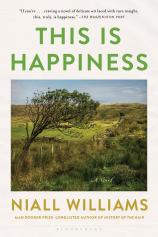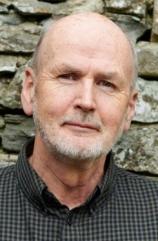This Is Happiness
Review
This Is Happiness
The second chapter of THIS IS HAPPINESS is simply beautiful. By way of introducing readers to Faha, a small Irish town in County Clare, Niall Williams describes the rain with such rhythm and grace as to render the whole chapter a poem. The first chapter reads, in its entirety, “It had stopped raining.” The contrast between the historically constant rain of Faha and the months-long dry spell that spans the action of the book is paralleled by several other key contrasts: youth and age, faith and disbelief, light and dark, tradition and future, love and loneliness, regret and forgiveness. While the startling brevity of the first chapter piques the interest, starting with the second chapter, Williams’ prose soars as it draws readers into Faha and introduces the colorful characters who live there.
Faha itself --- made up of the rolling, soggy hills, the rain, the long-standing church and pre-church traditions --- is vibrant and alive in THIS IS HAPPINESS. The story zooms in on two temporary residents: 17-year-old Noe Crowe, having left a Dublin seminary to live with his grandparents for a while, and Christy, a man in his 60s who has arrived to both connect the town to the national electric grid and reconnect with a woman he hasn’t seen in 50 years.
"This book cannot be recommended enough; it is lovely and authentic, heartbreaking yet joyful, immersive and canny, and an absolute delight to read."
Both men are at emotional crossroads, on the precipice of movement and change. They become fast friends and roommates, each finding themselves observers of Faha and intrinsically tied to the place. Noe has the greater connection to Faha and the greater number of choices before him. He narrates the novel from a distance of many decades, much hindsight and gained wisdom.
What happens in THIS IS HAPPINESS? The answer is everything and nothing at all. This is a contemplative novel that explores a web of themes, resulting in an insightful examination of the shared human experience and a pondering of life’s big questions.
On young Noe’s mind is nothing less than the meaning of life, the power of love, and the future as heralded by the arrival of electricity to Faha (the year is 1958, and still not all Fahaeans are convinced of the need). When he arrives in Faha trailing behind him a life of adventures and mistakes, Christy is close to the age that Noe is as he narrates the story. While Christy’s job is part of the electrical illumination of the town, the illumination he brings to Noe is much brighter and more impactful. Together they consider love, vocation and place, and seek out the best musicians and true companionship.
Of course, the lights get turned on in Faha, just as the phone lines had previously arrived. Of course, Christy imparts the sage insights Noe needs and then leaves. Of course, in reflecting back through time, Noe sees Faha, and himself, in ways that were not clear to his teenage self. These story-truths can be taken for granted in such a literary coming-of-age (coming-of-change) novel.
What makes THIS IS HAPPINESS so exceptional is Williams’ gorgeous and astute style, and his brilliant observations on the human condition --- that which is universal and that which is particularly Irish. This book cannot be recommended enough; it is lovely and authentic, heartbreaking yet joyful, immersive and canny, and an absolute delight to read.
Reviewed by Sarah Rachel Egelman on December 6, 2019
This Is Happiness
- Publication Date: August 31, 2021
- Genres: Fiction
- Paperback: 400 pages
- Publisher: Bloomsbury Publishing
- ISBN-10: 1635576318
- ISBN-13: 9781635576313




